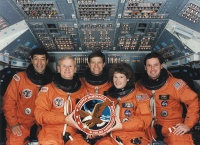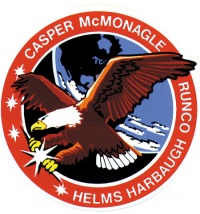STS-54
From The Space Library
 | |
| Organization | NASA-Office of Space Flight (United States), NASA-Office of Space Science Applications (United States) |
|---|---|
| Mission type | Astronomy,Human Crew,Life Science,Microgravity |
| Launch date | January 13, 1993 |
| Launch vehicle | Space Shuttle |
| Launch site | Cape Canaveral, United States |
| COSPAR ID | 1993-003A |
| Inclination | 28.45 degrees |
| Experiments | Here |
| Alternate Names | 22313 |
| Additional Information | Here |
| PDMP Information | Here |
| Telecommunications Information | Here |
| Data Collection | Here |
| Payload Mass Up | 21156 kg |
| Payload Mass Down | 4121.82 kg |
| Orbiter | Endeavour |
| Lift Off Mass | 2,055,769.09 kg |
| Orbiter Weight at Liftoff | 117,847.27 kg |
| Orbiter Weight at Landing | 89,899.09 kg |
| Landed | Concrete runway 33 at Kennedy Space Center, Fla. |
| Orbits of Earth | 96 |
| Orbital Altitude | 160 nautical miles (184 statute miles) |
Contents |
[edit] Crew
- Commander: John H. Casper
- Pilot: Donald R. McMonagle
- Payload Commander:
- Mission Specialist 1: Mario Runco Jr.
- Mission Specialist 2: Gregory J. Harbaugh
- Mission Specialist 3: Susan J. Helms
- Mission Specialist 4:
- Mission Specialist 5:
- Payload Specialist 1:
- Payload Specialist 2:
ISS/Mir Crew Transport
[edit] Mission
The STS 54 mission was the third flight of the orbiter Endeavour and was used to launch the sixth satellite in the Tracking and Data Relay Satellite (TDRS) series, TDRS-F. In addition, STS 54 carried a shuttle bay instrument called the Diffuse X-ray Spectrometer, or DXS, to make observations of the diffuse x-ray background in the Milky Way galaxy. Finally, several mid-deck experiments were performed, including: (1) the fourth flight of the CHROMEX series, this time studying the developmental and physiological processes influencing seed production in microgravity; (2) the second flight of the Commercial Generic Bioprocessing Apparatus (CGBA), a collection of 28 separate commercial investigations in biomedical testing and drug development, controlled ecological life support systems, and agricultural development and manufacture of biological-based materials; (3) the second flight of the Physiological and Anatomical Rodent Experiment (PARE), investigating the short-term effects of microgravity on the size, strength, and stamina of skeletal muscles; and, (4) the first flight of the Solid Surface Combustion Experiment (SSCE), to study the physical and chemical mechanisms of flame propagation over solid fueternally-imposed airflows.
[edit] EVA
Extravehicular Activity (EVA) conducted by Gregory J. Harbaugh and Mario Runco Jr., 4 hours, 28 minutes.
[edit] Payload
Tracking and Data Relay Satellite (TDRS)-F/ Inertial Upper Stage (IUS); Diffuse X-ray Spectrometer (DXS); Chromosome and Plant Cell Division in Space (CHROMEX); Commercial Generic Bioprocessing Apparatus (CGBA) A; Physiological and Anatomical Rodent Experiment (PARE) 02; Solid Surface Combustion Experiment (SSCE)
[edit] Books about the Space Shuttle Program
Buy This Book Click here |
Buy This Book here |
Buy This Book Click here |
Buy This Book Click here |





